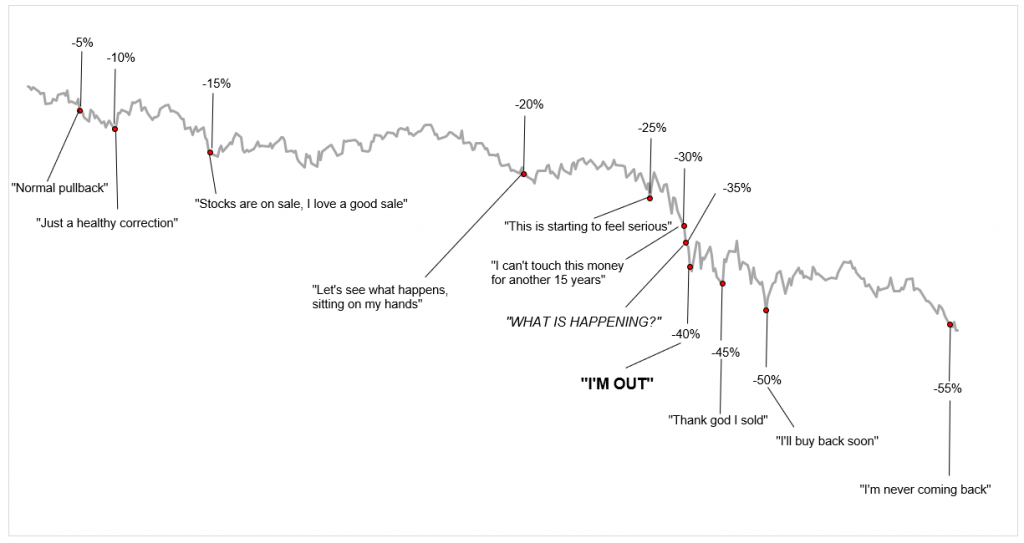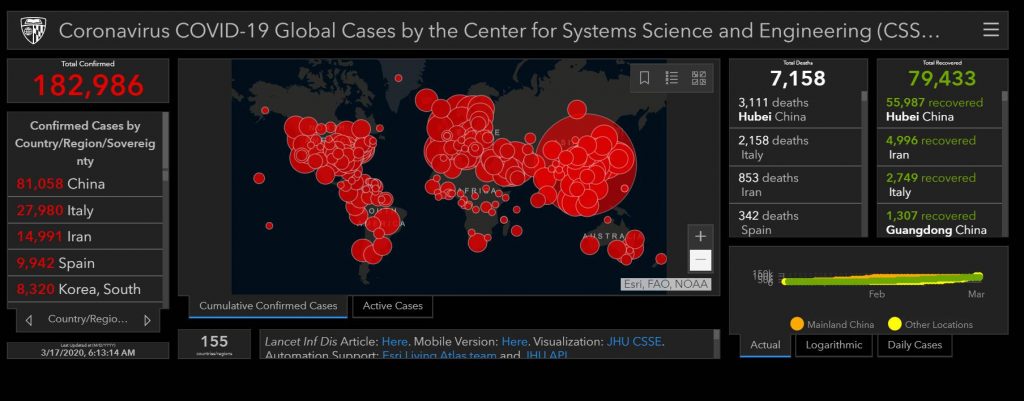1.S&P Plunged 29% in 18 Trading Days.
The S&P 500 index has now plunged 29% in the 18 trading days since the peak in February 19 and is below where it had first been on March 1, 2017 – which was over three years ago. In other words, the S&P 500 unwound three years’ worth of gains in 18 trading days.
S&P 500 Plunged Most Since 1987, Gave Up in 18 Days the 42% Gains of Past 3 Years. Boeing Shares Collapsed-Wolf Richter
2.S&P Pulls Back to Xmas Eve 2018 Levels.
SPY slightly above 2018 pullback levels.
3.Dow Jones and Dow Transports Crash Below 2018 Levels.
Industrials Break Thru 2018 Lows.
Transports chart-see that transports never made it to new highs
4.Small Cap Russell 2000 Back to 2016 Levels.
IWM Russell 2000 Small Cap ETF -see top of chart also did not make new highs
5.Comparing Selloffs-Lehman Bankruptcy vs. 2020 Corona.
Blackrock Blog
We see the shock as akin to a large-scale natural disaster that severely disrupts activity for one or two quarters, but eventually results in a sharp economic recovery.
The key assumption behind this view
Policy makers act to stabilize economies and forestall any cash-flow crunches that could lead to financial stresses and tip the economy into a financial crisis. The Fed on Sunday cut rates to near zero, announced up to $700 billion in bond purchases and other measures to ensure the proper functioning of markets, and set up arrangements with other central banks to make U.S. dollar funding available. The White House earlier unlocked disaster funding, and Congress is set to pass a bill to cover health care and paid leave for some workers. A more sizable fiscal response is possible amid growing recognition in Congress that this is needed. The UK last week delivered on a coordinated set of measures including a Bank of England rate cut and a budget that included relief to affected sectors. This, and similar moves by Canada last week, is the type of coordinated monetary and fiscal action that we have flagged a need for in dealing with the next downturn. The European Central Bank provided material relief to the banking system at the heart of financing the euro area economy, and several European nations signaled they will significantly loosen fiscal policy. Yet the ECB’s move was not the “whatever it takes” package markets had expected, and bond yields of some peripheral nations jumped.
Bottom line
We have recently downgraded our stance on risk assets to benchmark weight due to material uncertainties associated with the outbreak and its impact, including the effectiveness of public health measures and how long the threat of the virus will linger. Large declines in yields have further diminished the cushion that government bonds have to offer against risk-asset selloffs, reducing their portfolio diversification benefits. We still prefer U.S. Treasuries over lower-yielding peers for portfolio ballast, but acknowledge increasing risk of snapbacks from near historically low yield levels.
Mike Pyle, CFA, is Global Chief Investment Strategist for BlackRock, leading the Investment Strategy function within the BlackRock Investment Institute. He is a regular contributor to The Blog.
Why it’s not 2008 again https://www.blackrockblog.com/2020/03/16/its-not-2008-again-market-volatility-2020/
6.Corona Virus Cases vs. Shanghai Composite Stock Index
POSTED BY: JACOB WOLINSKY
Value Walk https://www.valuewalk.com/2020/03/confirmed-coronavirus-cv-cases/
Shanghai Stock Exchange Above 2019 Lows
7.S&P 500 Performance Around U.S. Recessions.
And the S&P 500 performance around US recessions
From Dave Lutz at Jones Trading
8.The Psychology of a Bear Market.
Michael Batnick

https://twitter.com/michaelbatnick/status/1238478781565853697/photo/1
9.Johns Hopkins Corona Virus Resource Center
One of my go to sites
From the United States
According to data compiled by Johns Hopkins University, there have been at least 1,662 confirmed cases of COVID-19 in the United States as of March 12. At least 41 people have died so far. The number of new cases jumped by as much as 400 on Thursday, March 12.

10.7 Tips to Manage Coronavirus Anxiety Now
Uncertainty is stressful for everyone. Here are ways to cope.
· Find a therapist to overcome anxiety
COVID-19 is beginning to cause unprecedented disruption in American life, after upending daily routines and threatening public health in many other countries. There is much uncertainty about what the next couple of weeks may hold on a day-to-day basis, and anxiety is on the rise not just for those who are prone to anxious thinking already, but even for individuals for whom it is not usually a problem. I am fielding an increasing number of questions about how to reduce stress in this somewhat chaotic time, and how to find the proper balance between preparation and panic. Here are some things to consider as we ride this out together.
1. Be mindful of your sleep and exercise. One of the first things to fall by the wayside in times of acute stress, especially when our usual routines are thrown out the window, is the daily rhythms of self-care. This has an unfortunate ripple effect because many of those self-care routines are exactly what keeps us feeling grounded and calm in the first place. (And it’s worth noting, they help keep our immune system in check as well.)
You may be tempted to go to bed later as you keep scrolling through your phone for news, or to ditch your usual walk around the block because you feel too frazzled. (Or you may be understandably hesitant to go to the gym as you typically do.) But letting go of these behaviors can backfire in the long-run. Prioritize adequate rest and moving your body wherever you can.
2. Use tools to calm your body. When we sense a threat, our peripheral nervous system goes into overdrive—it’s evolution’s way of making sure we were ready to fight that predator (or take flight from it). The problem is, evolution didn’t anticipate chronic states of stress very well. And when our bodily reactions to stress are sustained in a hyper-threat mode for long periods of time—the exact thing that may happen in times of prolonged, heightened sensitivity like these—they don’t do us any good, and in fact, can start to make us feel a lot worse.
And when your body is anxious, your brain often follows. Target the areas of your body where you feel your stress. Tight jaw? Clenched fists? Shallow breathing? Racing heart? Then look online for visualizations, diaphragmatic breathing exercises, mindful meditations, and progressive muscle relaxations that can help target those areas. Even slowly rolling your neck, or lying on the ground with legs elevated and slowing down your breathing, can go far in reducing in-the-moment anxiety.
3. Set limits on media, and choose only reliable sources. It is so hard to find the sweet spot between preparation and panic, between being informed versus ruminating on the same bad news over and over and over again. There will always be one more source to read, one more update to scroll through. How will you protect yourself from falling into the information-overload abyss?
Perhaps you allot yourself only 10 minutes of online news every two hours, or you decide not to take your smartphone to bed with you. Maybe you hide the people on your social media feed who tend to post dubiously-sourced material. However you choose to set them, boundaries are more important than ever to keep from spiraling.
4. Find social support even when social distancing. One thing I am particularly worried about as folks begin to isolate themselves (as necessary as that isolation is for public health) is that as we cut ourselves off from others, we may cut ourselves off from significant emotional support. Emotional support helps us recover more quickly from trauma, reduces our blood pressure, and helps us cope.
article continues after advertisement
Make sure that you are finding meaningful ways to still connect with those you love, even while you are not seeing them in person. And a sense of community is so important as well, so as you are online, look for more meaningful interactions than just clicking “like.” We are all in this together, and the more that we act accordingly, the better we will feel—and the more we can help each other.
5. Don’t let your catastrophic thoughts seep in as truth. In uncertain times, the brain looks to fill in gaps and connect dots. The problem is, this makes us create shortcuts. And it can drastically distort the lenses through which we see the world, to the point where we start accepting needlessly catastrophic thinking as fully accurate.
Strive to become a curious, gentle observer of your thoughts. Don’t automatically assume they are true. Know that there are all kinds of biases that make us more accepting of negative information as reliable, even when it’s not. We can also fall into all-or-none thinking that accentuates the negative of a situation or confirmation bias when we seek out only the information that aligns with our worst fears—dismissing or ignoring information that would actually help us calm down.
6. Keep the familiar and the predictable in place where you can. A sense of predictability and controllability have been shown to help reduce the stress response. The problem is, as with our self-care, we tend to throw our routines out the window when life gets unusual.
And this is understandable, of course—many of us are indeed stringing together days that look very different than our usual ones. We’ve stopped going to the places we usually do. We may not be going in to work. Our kids may be home from school. We may no longer be taking public transportation or gathering at our usual meeting places.
article continues after advertisement
So, try to find some predictability where you can. Maybe it’s taking comfort in eating the same breakfast you usually do, or having the same Friday night family movie night, or getting dressed professionally as you usually do, even though you’re logging in to work from your bedroom. Little aspects of keeping our routine can help us feel calmer.
7. Look for beauty and embrace gratitude when possible. I know it is difficult to be “thankful” when the world feels scary. But moments of beauty still exist, and if you can ground yourself in the here and now to see them—really seem them—you will give yourself a mood boost.
Maybe it’s the daffodil sprouting up from the courtyard, reminding you that the natural world will always keep blooming and bringing new hope. Maybe it’s the appreciation of our health care workforce and the admiration and gratitude for their bravery and compassion. Maybe it’s listening to a piece of music that always brings a sense of awe. Even small moments matter. And the more that you find them, the more you help nourish your mind and your heart—which are getting quite tested these days and need all the love they can get.
Photo by Priscilla Du Preez on Unsplash.








